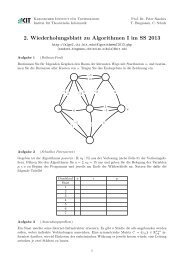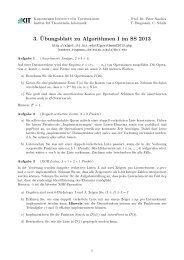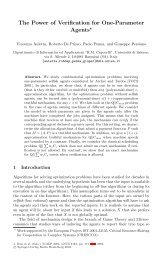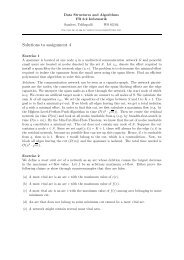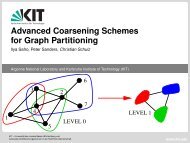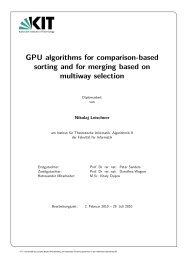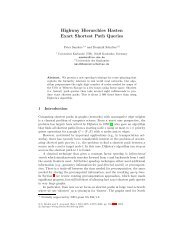Stxxl : Standard Template Library for XXL Data Sets - Max-Planck ...
Stxxl : Standard Template Library for XXL Data Sets - Max-Planck ...
Stxxl : Standard Template Library for XXL Data Sets - Max-Planck ...
You also want an ePaper? Increase the reach of your titles
YUMPU automatically turns print PDFs into web optimized ePapers that Google loves.
In Listing 2 we give an example how to program block I/O using objects of the BM layer. In<br />
Line 2 we define the type of block: its size is one megabyte and the type of elements isdouble. The<br />
pointer to the only instance of the singleton object block manager is obtained in Line 5. Line 6<br />
asks the block manager to allocate 32 blocks in external memory. The new blocks call writes the<br />
allocated BIDs to the output iterator, given by the last parameter. The std::back inserter<br />
iterator adapter will insert the output BIDs at the end of the array bids. The manager assigns<br />
blocks to disks in a round-robin fashion as the striping() strategy suggests. Line 7 allocates<br />
32 internal memory blocks. The internal memory allocator new alloc of <strong>Stxxl</strong><br />
allocates blocks on a virtual memory page boundary, which is a requirement <strong>for</strong> unbuffered file<br />
access. Along Lines 8–10 the elements of blocks are filled with some values. Then the blocks are<br />
submitted <strong>for</strong> writing (lines 11–12). As in the AIO example, I/O is overlapped with computations<br />
in functiondo something(). After the completion of all write requests (Line 14) we per<strong>for</strong>m some<br />
useful processing with the written data (function do something1()). Finally we free the external<br />
memory space occupied by the 32 blocks (Line 16).<br />
Listing 2: Example of how to program using the BM layer.<br />
1 using namespace stxxl ;<br />
2 typedef typed_block block_type ;<br />
3 std : : vector bids ; // empty array of BIDs<br />
4 std : : vector requests ;<br />
5 block_manager ∗ bm = block_manager : : get_instance ( ) ;<br />
6 bm−>new_blocks(32,striping () ,std : : back_inserter (bids ) ) ;<br />
7 std : : vector blocks (32);<br />
8 <strong>for</strong> ( int ii = 0; ii < 32; ii++)<br />
9 <strong>for</strong> ( int jj=0; jj < block_type : : size ; jj++)<br />
10 blocks [ii ] [ jj ] = some_value (ii ,jj ) ;<br />
11 <strong>for</strong> ( int i = 0; i < 32; i++)<br />
12 requests .push_back ( blocks [i ] . write(bids [i] ) ) ;<br />
13 do_something ( ) ; // do something () i s overlapped with writing<br />
14 wait_all (requests .begin () , requests .end ( ) ) ; // wait until a l l I /Os f i n i s h<br />
15 do_something1 (bids .begin () ,bids .end ( ) ) ;<br />
16 bm−>delete_blocks (bids .begin () , bids .end ( ) ) ; // deallocate ext . memory<br />
2.3 STL-user Layer<br />
When we started to develop the library we decided to equip our implementations of external<br />
memory data structure and algorithms with well known generic interfaces of data structures and<br />
algorithms from the <strong>Standard</strong> <strong>Template</strong> <strong>Library</strong>, which is a part of C++ standard. This choice<br />
would shorten the application development times, since the time to learn new interfaces is saved.<br />
Porting internal memory code that relies on STL would also be easy, since interfaces of STLuser<br />
layer data structures (containers in the STL terminology) and algorithms have the same<br />
syntax and semantics. Another advantage is that compatible interfaces will allow to reuse the<br />
I/O-efficient code, existing in STL (e.g. scanning and selection algorithms).<br />
Containers<br />
We go over the containers currently available in <strong>Stxxl</strong>.<br />
The most universal <strong>Stxxl</strong> container is stxxl::vector. Vector is an array whose size can<br />
vary dynamically. The implementation of stxxl::vector is similar to LEDA-SM array [11].<br />
The content of a vector is striped block-wise over the disks using an assignment strategy given<br />
as a template parameter. Some of the blocks are cached in a vector cache of fixed size (also<br />
a parameter). The replacement of cache blocks is controlled by a specified page-replacement<br />
7




